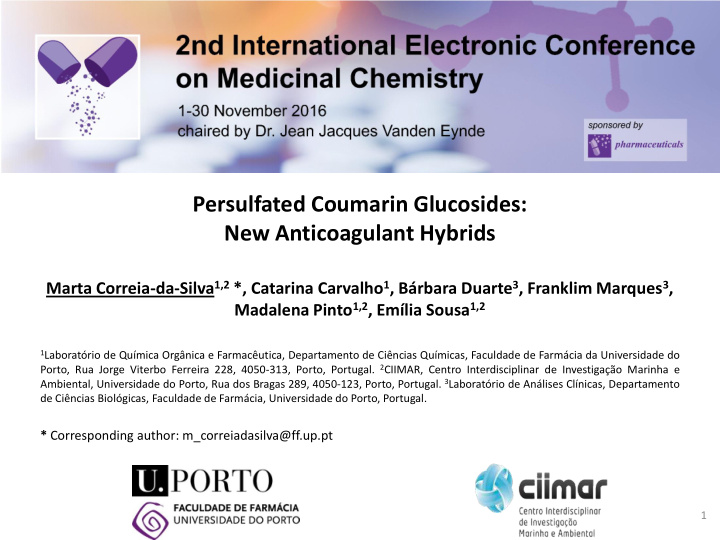



Persulfated Coumarin Glucosides: New Anticoagulant Hybrids Marta Correia-da-Silva 1,2 *, Catarina Carvalho 1 , Bárbara Duarte 3 , Franklim Marques 3 , Madalena Pinto 1,2 , Emília Sousa 1,2 1 Laboratório de Química Orgânica e Farmacêutica, Departamento de Ciências Químicas, Faculdade de Farmácia da Universidade do Porto, Rua Jorge Viterbo Ferreira 228, 4050-313, Porto, Portugal. 2 CIIMAR, Centro Interdisciplinar de Investigação Marinha e Ambiental, Universidade do Porto, Rua dos Bragas 289, 4050-123, Porto, Portugal. 3 Laboratório de Análises Clínicas, Departamento de Ciências Biológicas, Faculdade de Farmácia, Universidade do Porto, Portugal. * Corresponding author: m_correiadasilva@ff.up.pt 1
Persulfated Coumarin Glucosides: New Anticoagulant Hybrids Graphical Abstract HYBRIDIZATION Mimic warfarin Mimic heparin Mimic heteroaromatic substituents 2
Abstract Coumarins are a large class of naturally occurring phenolic substances consisting in fused benzene and α - pyrone rings (benzo- α -pyrones). Coumarins are extremely variable in structure, due to different types of substituents in their scaffold, which can influence their biological activity. Coumarin-derivatives possessing a 4-hydroxyl group have been therapeutically used for their orally anticoagulant activity (e.g. warfarin). Nevertheless, being vitamin K antagonists, coumarins have a delayed onset and offset of action and several interactions with many drugs and food. In opposite, heparin, which is a polysulfated polysaccharide, has a short onset and offset of action, due to an effective mechanism of action, but is only active by parenteral route. As a result, it is important to develop effective orally active antithrombotic agents. In this work, a hybridization strategy was planned joining a coumarin scaffold with a heparin-like sugar sulfated moiety. With this approach it is expected to mimetize the sulfated polysaccharide anticoagulants, while adding some hydrophobic character to the resulting molecule to achieve oral bioavailability. Five persulfated triazole and non-triazole linked coumarin glucosides were obtained by microwave irradiation with triethylamine-sulfur trioxide adduct, and their structure elucidation was established by IR and NMR for the first time. A purification procedure involving dialysis with a cellulose membrane was successfully applied to remove water soluble impurities. The anticoagulant activity was measured by the classical clotting times - activated partial thromboplastin time (APTT), prothrombin time (PT), and thrombin time (TT). The most active compound exhibited an APTT 2 of 22×10 -5 M. In the future, oral bioavailability of this innovative coumarin hybrid will be evaluated. Keywords: sulfated, coumarins, synthesis, anticoagulant 3
Anticoagulant Therapy COUMARINS 4-hydroxycoumarins Anti-inflammatory Antihypertensive Antibacterial Anticoagulant Anticancer Antifungal Antiviral Vitamin K antagonists Food and drugs interactions 4
Anticoagulant Therapy HEPARIN Thrombin, Factor Xa, and Platetet factors Inhibitor Bovine or porcine sources Active only by parenteral route Development of effective orally active antithrombotic agents 5
Strategy for the development of new anticoagulant coumarins Hybridization Mimic warfarin Mimic heparin Mimic heteroaromatic substituents New anticoagulant coumarins with different mechanism of action ? 6
Persulfated (non-)triazole linked coumarin glucoside (a) TBAHS, CsCO 3 , 65°C; (b) NaN 3 , r.t.; (c) Sodium ascorbate, Cu 2 SO 4 .5H 2 O, THF/H 2 O, MW, 70°C; (d) NaOMe, MeOH, r.t.; (e) TEA:SO 3 , DMA, MW, 100°C; (f) TBAB, K 2 CO 3 , r.t. 7
Persulfated triazole-linked coumarin glucoside IR spectrum (KBr) of persulfated triazole-linked coumarin glucoside 8
Persulfated triazole-linked coumarin glucoside 13 C NMR 1 H NMR 8.54 5.16 142.2 124.3 61.7 1 H NMR spectrum (300 MHz) of persulfated 13 C NMR spectrum (75.47 MHz) of persulfated triazole-linked coumarin glucoside (DMSO – d 6 ) triazole-linked coumarin glucoside (DMSO – d 6 ) 9
Anticoagulant activity The anticoagulant activity was measured by the classical clotting times: activated partial thromboplastin time ( APTT ), prothrombin time ( PT ), and thrombin time ( TT ) - in five different concentrations Citrated normal human plasma mixed (1:1) with sample solution (50 μ L) was incubated for 2 min at 37°C Plasma mixed with compound Sample place cuvette rotor ACL-100 solution Correia-da-Silva M, Sousa E, Duarte E, Marques F, Carvalho F, Cunha-Ribeiro LM, Pinto M, J. Med. Chem., 2011 , 54, 95-106. Correia-da-Silva M, Sousa E, Duarte E, Marques F, Carvalho F, Cunha-Ribeiro LM, Pinto M, J. Med. Chem., 2011 , 54, 5373-5384. 10
Anticoagulant activity The sulfated derivatives (4b, 5b, 6b, 8a, and 9a) showed anticoagulant properties in a dose-dependent manner. All non-sulfated parent compounds were inactive in all clotting times. APTT was the most sensitive test to the presence of these persulfated coumarins. Although warfarin affects the APTT, the APTT is less sensitive to warfarin then is the PT, which is not the case of these new coumarins. The double concentration for APTT of the most potent derivative was 22 x 10 -5 M. 11
In this work four different molecular modifications were applied to the coumarin scaffold. Twelve new coumarin derivatives were synthesized. The anticlotting activity of the five sulfated derivatives was evaluated. The new sulfated coumarin hybrids showed anticlotting profile different from warfarins. 12
PTDC/MAR-BIO/4694/2014 (POCI-01-0145-FEDER-016790) PTDC/AAG-TEC/0739/2014 (POCI-01-0145-FEDER-016793) 13
Recommend
More recommend